Extraction, Antioxidant Activity and Characterization of Essential Oils of Different Spices
Keywords:
essential oil, distillation, spice, antioxidant activity, gas chromatography-mass spectrometryAbstract
Essential oils of five different common spices in cinnamon, cumin, cardamom, wisteria and coriander were extracted by hydrodistillation and steam distillation. The yield percentages of oils extracted by each method were calculated and compared. The yield percentages of cinnamon, cumin, cardamom, wisteria, and coriander oils obtained by hydrodistillation are 1.9, 2.0, 2.8, 1.7 and 1.0%, respectively. The yield percentages of cinnamon, cumin, cardamom, wisteria, and coriander oils obtained by steam distillation are 0.7, 0.8, 1.2, 0.5 and 0.5%, respectively. Hydrodistillation provided higher yield compared to steam distillation. The antioxidant activity of each spice was determined in terms of antioxidant activities due to volatile oil and non-volatile components of spice by DPPH radical scavenging activity method. The highest percentage antioxidant activity due to volatile oil was of cinnamon with 69.27%. The highest percentage of antioxidant activity due to non-volatile component of spice was of coriander with 90.79%. The composition of fresh spice extracts and essential oil of each spice was determined by gas chromatography-mass spectrometry (GC-MS). The most common components found in spice samples were D-Limonene, α-Terpinene, γ-Terpinene, β-Thujene, Ocimene, Camphene, α-Phellandrene, 3-Carene, α-Fenchene, Cuminaldehyde, α-Terpineol and 4-Terpinyl acetate
References
Elshafie H. S., Camele I., ?An Overview of the Biological Effects of Some Mediterranean Essential Oils on Human Health?, BioMed Res. Int., Vol. 2017, pp. 1-14, 2017.
Ali B., Al-Wabel N. A., Shams S., Ahamad A., Khan S. A., Anwar D., ?Essential oils used in aromatherapy: A systemic review?, Asian Pac. J. Trop. Biomed., Vol. 5, Issue. 8, pp. 601-611, 2015.
Blowman K., Magalh?es M., Lemos M. F. L., Cabral C., Pires I. M., ?Anticancer Properties of Essential Oils and Other Natural Products?, Evid. Based Complement. Alternat. Med., Vol. 2018, pp. 1-12, 2018.
Elyemni M. et al., ?Extraction of Essential Oils of Rosmarinus officinalis L. by Two Different Methods: Hydrodistillation and Microwave Assisted Hydrodistillation?, Sci. World J., Vol. 2019, pp. 1-6, 2019.
Dinh Phuc N., Phuong Thy L. H., Duc Lam T., Yen V. H., Thi Ngoc Lan N., ?Extraction of Jasmine Essential Oil By Hydrodistillation method and Applications On Formulation of Natural Facial Cleansers?, IOP Conf. Ser. Mater. Sci. Eng., Vol. 542, pp.1-15, 2019.
Al-Salman F., Ali Redha A., Al-Zaimoor Z., ?Inorganic Analysis and Antioxidant Activity of Shilajit?, Int. J. Sci. Res. Chem. Sci., Vol. 7, Issue. 3, pp. 5-10, 2020.
Ali Redha A. A., Hasan A. M., Mandeel Q, ?Phytochemical Determinations of Pomegranate (Punica granatum) Rind and Aril Extracts and their Antioxidant, Antidiabetic and Antibacterial Activity?, Nat. Prod. Chem. Res., Vol. 6, Issue. 4, pp. 1-10, 2018.
Shahid M. Z., Saima H., Yasmin A., Nadeem M. T., Imran M., Afzaal M., ?Antioxidant capacity of cinnamon extract for palm oil stability?, Lipids Health Dis., Vol. 17, Issue. 1, pp. 1-8, 2018.
Wang C. W., Chen Y. W., Hou C. Y., ?Antioxidant and antibacterial activity of seven predominant terpenoids?, Int. J. Food Prop., Vol. 22, Issue. 1, pp. 230-238, 2019.

Downloads
Published
How to Cite
Issue
Section
License

This work is licensed under a Creative Commons Attribution 4.0 International License.
Authors contributing to this journal agree to publish their articles under the Creative Commons Attribution 4.0 International License, allowing third parties to share their work (copy, distribute, transmit) and to adapt it, under the condition that the authors are given credit and that in the event of reuse or distribution, the terms of this license are made clear.





